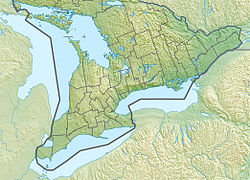| Darlington Provincial Park | |
|---|---|
 View of McLaughlin Bay | |
Location in Southern Ontario | |
| Location | Durham Region, Ontario, Canada |
| Nearest city | Bowmanville, Ontario |
| Coordinates | 43°52′23″N78°47′13″W / 43.873°N 78.787°W |
| Area | 208 ha (510 acres) |
| Established | 1959 |
| Visitors | 195,123(in 2022 [2] ) |
| Governing body | Ontario Parks |
| Website | www |
 | |
Darlington Provincial Park is a provincial park in Ontario, Canada. It is located just south of Highway 401 in the city of Bowmanville. A small park, the topography is dominated by gentle hills formed by a terminal moraine deposited by glaciers at the end of the last Ice Age. The park borders on the northern shore of Lake Ontario and also encloses McLaughlin Bay. The bay is shallow and at some point in the 1990s was completely closed off from the lake by the action of the waves. The property bordering the park to the west is the home of General Motors Corporation's Canadian headquarters. Kintigh Generating Station can be seen from this provincial park even though it is on the other side of the lake in Somerset, New York.


